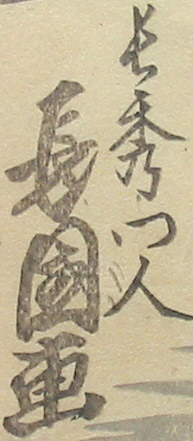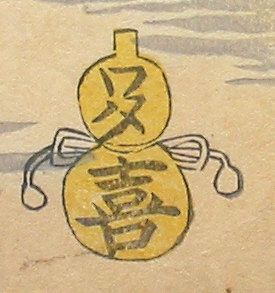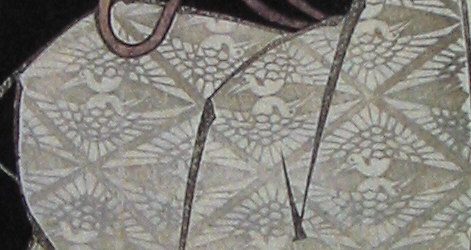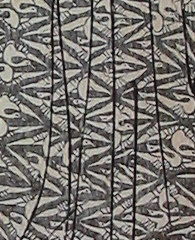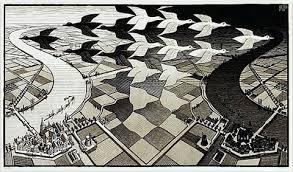 |
JAPANESE PRINTS
A MILLION QUESTIONS
TWO MILLION MYSTERIES
Ukiyo-e Prints浮世絵版画 |
|
Kansas City, Missouri |
|
NAGAKUNI |
|
長国 |
|
Active 1814-20 |
|
Scene from the play "Gion Sairei Shinkōki" 祇園祭礼信仰記 |
|
Nakamura Utaemon III 三代中村歌右衛門 as Konoshita Tōkichi 此下東吉 |
|
Signed: Nagahide monjin Nagakuni ga (Pupil of Nagahide) |
|
Ca. 1816 |
|
Publisher: Wata-ya Kihei 綿屋喜兵衛 |
|
15" x 10 1/8" |
|
SOLD |
|
THANKS! |
|
|
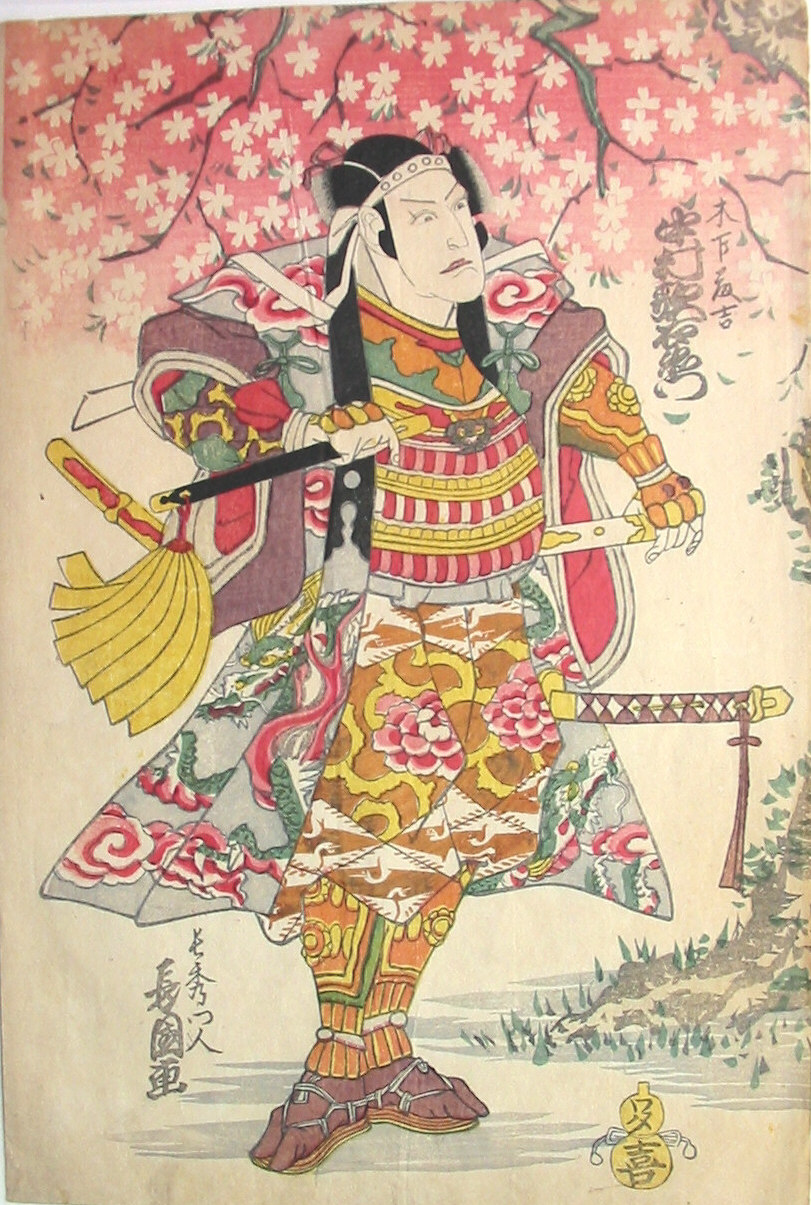 |
|
Gion Sairei Shinkoki |
|
|
|
Konoshita Takichi is one of the good guys of this play. His master, the shogun Ashikaga Yoshiteru, has been overthrown by the treachery of Matsunaga Daizen. Daizen imprisons the mother of the late shogun and Takichi - as a ploy - offers to serve the usurper, but really is trying to rescue the captive. Daizen doesn't trust Takichi and challenges him to a game of go. When Takichi wins Daizen throws the "counter box... into a well and orders Takichi to retrieve it while keeping his hands dry. The clever Tokichi manages to do this by running water into the well so that it rises, bringing the box, which he removes on a fan, with it." He delivers the box to Daizen who then takes him into his service.
In another scene Takichi fends of attackers and climbs a cherry tree. Perhaps that is what is represented by this print. Takichi then convinces the late shogun's mother not to commit suicide for the sake of her infant grandson who is now the new shogun.
***
This play was based on the life of the 16th century warlord, Oda Nobunaga, but the names were changed to protect the innocent (authors, actors, theaters, etc.)
***
The play owes much to the composition written by Chikamatsu Monzaemon for the puppet theater in 1719. Today only the fourth act is produced on the stage. Although this print dates from a performance in circa 1816 this play has been used by several other artists of later dates for their own work: Yoshitora in 1862, for example. |
|
NAGAKUNI'S CONTRIBUTIONS TO THE WORLD OF OSAKA PRINTS |
|
Roger Keyes and Keiko Mizushima state in their The Theatrical World of Osaka Prints (Philadelphia Museum of Art, 1973, p. 207) that Nagakuni, better known as Ashiyuki, "...has been unfairly neglected as an Osaka print designer." they point out that he created many firsts in Osaka prints: the first to use horizontal format; the first to use gofun to create the sense of snow; the first to use small-figure surimono style; and the first to use color blocks without outlines. They further state that "...at his best he designed some of the masterpieces of the Osaka school and, in a quiet way, anticipated most advances of Osaka style.
In the introduction to the Philadelphia catalogue Keyes and Mizushima point out one further distinction about this artist: "...Ashiyuki introduced the startling visual contrast between meticulously engraved and brilliantly printed ukiyoe-style figures against pale, painterly Shijo-style grounds."
*****
Personally I could not have told you why I originally acquired this print except for its strength of color, imagery and early date - although I am drawn to early Osaka oban prints. However, after reading what Keyes and Mizushima wrote - quoted above - my choice only makes sense. Notice the lineless printing both in the flowering tree in the background and in the floral and cloud motifs on his clothing plus the Shijō style and hence more painterly description of the ground where his feet are so solidly planted, the tree trunk and roots and the greenery sprouting nearby. |
|
|
長国画 |
長 秀 門 人
|
|
|
木下 ? 吉 |
||
|
|
|
|
|||||
|
SIGNATURE: Nagahide monjin Nagakuni ga (Picture by a pupil of Nagahide ) |
|
|
|||||
|
Publisher's seal to the right: Wataya Kihei |
|||||||
|
Nakamura Utaemon III and the Osaka Stage |
|
|
Utaemon was the hottest thing to hit the Osaka stage in the early decades of the nineteenth century. His career coincided with the development of the oban actor print. Capable of performing both male and female roles his imagery came to dominate the majority of prints being produced for quite some time. Not only did he perform in his home base of Osaka, but he also was an influence in Edo. However, his time spent in the shogun's capital was not exactly smooth. Competing fans of other actors brawled with Utaemon's devotees to the point that some of them had to be arrested. In Fact, Utaemon suffered a shiner from one such encounter. When he left Edo before the end of his contract he described it as "leaving the darkness for the light of day." In time he was forced to return to Edo to complete his agreement, but this time he showed up in disguise as his own fictitious twin brother Nakamura Shikan.*
"Edo's loss was Osaka's gain"
His fans turned out in droves to welcome him home in 1815. His reception was said to be more spectacular than Osaka's greatest festival. Imitation and groveling were not uncommon: at one restaurant the staff wore Utaemon's favorite color; pastries called tsuru-bishi were modeled on his family crest of a crane within a lozenge shape; "One merchant insisted that his clients cover any wild orange-blossom crests that might appear on their robes" because that motif was used by one of Utaemon's chief rivals.
Utaemon was a capable and popular writer of poetry and plays and was connected with the other literary figures of Osaka. |
|
|
Source Material for the information found above comes from Osaka Prints, Dean J. Schwaab, Rizzoli, 1989, pp. 20-22. |
|
|
|
|
|
The inset to the right is the tsuru-bishi or lozenge shaped crane motif used by Utaemon and visible on the lower part of his costume seen in the print above. |
|
|
To the right is a detail of a very subtle example of the tsuru-bishi motif on another print of Nakamura Utaemon III. |
|
|
|
|
|
Sometimes the tsuru-bishi is only a beautiful fabric design with no real connection with Nakamura Utaemon III - perhaps not even metaphorically. This example is from ca. 1805.
|
|
|
|
|
|
The detail to the right is from an Eisen print ca. 1830. |
|
|
|
|
|
Whereas there is no relationship between the M.C. Escher detail from a print called "Day and Night" on the right and the tsuru-bishi crest shown above it the comparison is interesting. Escher's actual source was the interlocking Moorish tiles found in the Alhambra in Granada, Spain. |
|
|
|
|
|
|
|
|
*When I read about Utaemon's attempted ruse to come back as his supposed twin brother Nakamura Shikan to ease his safe return onto the Edo stage I was reminded of the circumstances surrounding the screen death of one of the popular characters of the "Mary Hartman, Mary Hartman" television show in the late 70s. Garth Gimbel, played by Martin Mull, was an abusive husband who died after his wife shoved him into a closet to slow his attack. Little did we know that he would be impaled on an old, fake Christmas tree. As I recall there was such an outcry from the fans that sometime later Mull was brought back as the deceased Garth's twin brother Barth who went on to a successful career as the host of his own television talk show.
Even Shakespeare was not above such switcheroos. Why not Nakamura Utaemon and his brother Barth...er, I mean, Nakamura Shikan? |
|
|
"Despite his short stature, husky voice, and unprepossessing looks, his great skill, inventive methods, and exceeding cleverness bowled audiences over in Edo, Kyoto, and Osaka." Quoted from: New Kabuki Encyclopedia: A Revised Adaptation of kabuki jiten, Samuel L. Leiter, Greenwood Press, 1997, p. 451. |
|
 HOME HOME |
